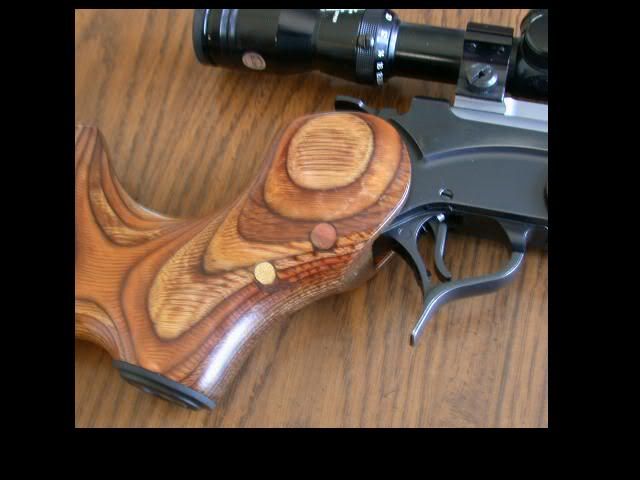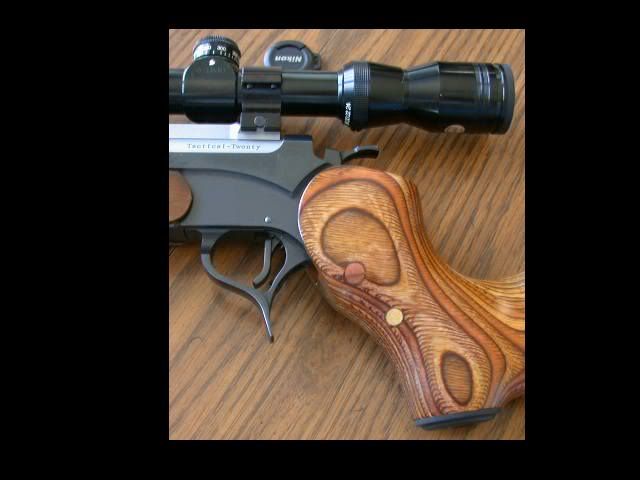

 The Accurate Reloading Forums
The Accurate Reloading Forums  THE ACCURATE RELOADING.COM FORUMS
THE ACCURATE RELOADING.COM FORUMS  Guns, Politics, Gunsmithing & Reloading
Guns, Politics, Gunsmithing & Reloading  Gunsmithing
Gunsmithing  Cracked Stock
Cracked StockGo  | New  | Find  | Notify  | Tools  | Reply  |  |
| One of Us |
I picked up a 1930's Anschutz Mauser a few months ago. It had a crack showing on the surface at the time. Well, once I received it, the crack extended through the stock, it basically starts on the left side of the rear tang on the surface and extends through the center of the stock (not surface) that separates the trigger well from the magazine well. I wanted to keep the stock as original as possible (though someone did refinish it prior and recut the checkering), but looks like I'm going all the way now with a complete epoxy bedding job (which I know how to do well). The question I had was repairing the crack. Here's what I have done so far: 1. Drilled a hole into the crack near the tang - again more towards the surface - the follows the crack line below surface 2. Drilled holes through along the crack line in the wood that separates the trigger and mag well 3. Expanded diameter of rear tang screw hole in stock 4. Removed wood and old finish where necessary to ensure the stock does not stress/expand when inserting the trigger guard assembly and barreled action. There was stress here when I received the rifle and assume that's what lead to the crack. What I plan to do 1. Epoxy drilled hole in rear of tang and wood bridge separating trigger and mag well. I plan to use 30 minute two part epoxy that I used to use for high power rockets (not the ones you buy in the store, the ones that break the sound barrier and have 10K feet altitude) 2. Once this is done, then do a complete bedding job with Devcon (the good two part steel putty, all I use know) 3. I plan to use a plastic bedding block in place of the trigger to maximize the epoxy "mass" inside the stock 4. Bedding trigger guard (front and rear) as well (and of course the barreled action) Does this sound right? "Evil is powerless if the good are unafraid" -- Ronald Reagan "Ignorance of The People gives strength to totalitarians." Want to make just about anything work better? Keep the government as far away from it as possible, then step back and behold the wonderment and goodness. | ||
|
one of us |
This type of crack is very common on Mausers, espically if they have been inletted to tight in the magazine well area. Personally I would not have drilled the holes. You did gain better access for the epoxy to penetrate, but at the cost of surface area. I have had very good luck by clamping the stock to close the cracks, the covering the outside of the crack with epoxy. Then you release the clamps and gently pry the stock apart to open the crack. This draws the epoxy into the crack. Usually you have to repeat this several times to get the epoxy into the crack. A better way is to use compressed air to force the epoxy into the crack. Even blowing air through a small straw(like the red ones made for stirring coffee) will get the job donne on most cracks. Regardless, after you epoxy the crack a small hidden cross bolt/pin can really add to the strength of the repair Jason "You're not hard-core, unless you live hard-core." _______________________ Hunting in Africa is an adventure. The number of variables involved preclude the possibility of a perfect hunt. Some problems will arise. How you decide to handle them will determine how much you enjoy your hunt. Just tell yourself, "it's all part of the adventure." Remember, if Robert Ruark had gotten upset every time problems with Harry Selby's flat bed truck delayed the safari, Horn of the Hunter would have read like an indictment of Selby. But Ruark rolled with the punches, poured some gin, and enjoyed the adventure. -Jason Brown | |||
|
one of us |
And expoxying a pillar into the rear action screw hole can also help hold things together in that area. I really, really rough the pillar up before epoxying it as I believe this adds strength to the glue joint. Also, I should disclose that I am halfway between "total hack" and "complete gun butcher". Jason "You're not hard-core, unless you live hard-core." _______________________ Hunting in Africa is an adventure. The number of variables involved preclude the possibility of a perfect hunt. Some problems will arise. How you decide to handle them will determine how much you enjoy your hunt. Just tell yourself, "it's all part of the adventure." Remember, if Robert Ruark had gotten upset every time problems with Harry Selby's flat bed truck delayed the safari, Horn of the Hunter would have read like an indictment of Selby. But Ruark rolled with the punches, poured some gin, and enjoyed the adventure. -Jason Brown | |||
|
| One of Us |
i wouldn't have drilled the holes either, but now that you have, i had to re-repair a stock similar to this a while back. I ended up routing out the wood between the holes and buring some stainless mesh in accraglass, filling up the entire cavity. kinda looked like hell, but it held up | |||
|
| One of Us |
Hi, I agree with Jason on the pillar and methodology for getting the epoxy where you need. Two things to consider: 1. Do not use fast setting epoxy, it does not have the strength of slow-set.2. Think about buying a short length of 1/8" brass all- thread and run that into the holes you have drilled. Some, if not all, of your drilled holes will connect the 2 sides of the crack. Epoxy impregnate, clamp tightly, run the all-thread in slowly with a cordless, snip off all-thread and proceed to next hole. Makes an incredibly strong mechanical and epoxy bond. Luck, Stephen | |||
|
| One of Us |
Thanks I will show pics as a I progess. I keep telling myself, just fix the crack and bed the stock; do not refinish the entire stock! "Evil is powerless if the good are unafraid" -- Ronald Reagan "Ignorance of The People gives strength to totalitarians." Want to make just about anything work better? Keep the government as far away from it as possible, then step back and behold the wonderment and goodness. | |||
|
| one of us |
Like others I wouldn't have drilled the holes. I would have cut a groove across the crack to fit a small piece of threaded rod. Probably in more than one place. As usual just my $.02 Paul K | |||
|
| One of Us |
Hmmm - I have done many many repairs on wooden boats with epoxy - epoxy is a friend of wood and so is my friend (so to speak) - we buy it by the 5 gallon jug here (not like real boat builders who buy it by the 55 gallon drum !) Anyway, drilling the holes in not a bad thing at all, while running thin/thinned epxoy into cracks is ok, it'll never give you the strenght that normal viscosity expoxy filled with appropiate fibre/glue powder will. The only way you can get this into cracks it to open them right up i.e. gouging the crack right out/drilling holes. The main problem you'll strike is that glue powders/fibres are invariably white or light coloured - so if the expoy shows on the outside it is hard to disguise. You can darken things by mixing a small amount of graphite with the epoxy (there are other pigments that are compatible but they are seldom to hand) or making walnut sawdust and mixing that in. Cheers - Foster | |||
|
| one of us |
You could also do a variation of this, if you can possibly get around the checkering:   I drilled & tapped the two holes in the stock, threaded the dowels, and set them in with the 30 minute epoxy while clamping the pizz out of the stock. This has held up for over ten years. | |||
|
| Powered by Social Strata |
| Please Wait. Your request is being processed... |
|

Visit our on-line store for AR Memorabilia

